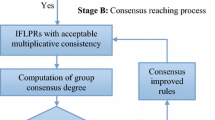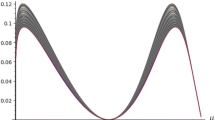Abstract
Interval linguistic fuzzy preference relations (ILFPRs) are powerful tools to denote the decision makers’ uncertain qualitative preferences. To avoid the inconsistent ranking results, consistency analysis is very critical. This paper introduces a new additive consistency concept for ILFPRs, which satisfies all properties of the additive consistency concept for fuzzy preference relations. Then, a model to judging the additive consistency of ILFPRs is constructed. When ILFPRs are inconsistent, an approach to deriving additive consistent ILFPRs is presented. Considering the incomplete case, goal programming models to determining the missing values are established. Subsequently, a distance measure-based group consensus index is given to measuring the consensus of individual ILFPRs. Furthermore, a new method for group decision making with ILFPRs is developed, which is based on the additive consistency and consensus analysis. Finally, two numerical examples are offered to show the application of the developed procedure, and a comparison analysis is performed.

Similar content being viewed by others
References
Alonso S, Cabrerizo FJ, Chiclana F, Herrera F, Herrera-Viedma E (2009) Group decision-making with incomplete fuzzy linguistic preference relations. Int J Intell Syst 24(2):201–222
Ben-Arieh D, Chen ZF (2006) Linguistic-labels aggregation and consensus measure for autocratic decision making using group recommendations. IEEE Trans Syst Man Cybern A 36(3):558–568
Büyüközkan G, Güleryüz S (2014) A new GDM based AHP framework with linguistic interval fuzzy preference relations for renewable energy planning. J Intell Fuzzy Syst 27(6):3181–3195
Cabrerizo FJ, Heradio R, Pérez IJ, Herrera-Viedma E (2010) A selection process based on additive consistency to deal with incomplete fuzzy linguistic information. J Univ Comput Sci 16(1):62–81
Chen HY, Zhou LG, Han B (2011) On compatibility of uncertain additive linguistic preference relations and its application in the group decision making. Knowl Based Syst 24(24):816–823
Delgado M, Verdegay JL, Vila MA (1993) On aggregation operations of linguistic labels. Int J Intell Syst 8(3):351–370
Dong YC, Xu YF, Li H (2008) On consistency measures of linguistic preference relations. Eur J Oper Res 189(2):430–444
Dong YC, Xu YF, Li HY, Feng B (2010) The OWA-based consensus operator under linguistic representation models using position indexes. Eur J Oper Res 203(2):455–463
Herrera F (1995) A sequential selection process in group decision making with linguistic assessment. Inf Sci 85(4):223–239
Herrera F, Martínez L (2000) A 2-tuple linguistic representation model for computing with words. IEEE Trans Fuzzy Syst 8(6):746–752
Herrera F, Herrera-Viedma E, Verdegay JL (1996a) A model of consensus in group decision making under linguistic assessments. Fuzzy Set Syst 78(1):73–87
Herrera F, Herrera-Viedma E, Verdegay JL (1996b) Direct approach processes in group decision making using linguistic OWA operators. Fuzzy Set Syst 79(2):75–190
Herrera F, Herrera-Viedma E, Verdegay JL (1997a) A rational consensus model in group decision making using linguistic assessments. Fuzzy Set Syst 88(1):31–49
Herrera F, Herrera-Viedma E, Verdegay JL (1997b) Linguistic measures based on fuzzy coincidence for reaching consensus in group decision making. Int J Approx Reason 16(3–4):309–334
Herrera-Viedma E, Chiclana F, Herrera F, Alonso S (2007) Group decision making model with incomplete fuzzy preference relations based on additive consistency. IEEE Trans Syst Man Cybern B 37(1):176–189
Liu F (2009) Acceptable consistency analysis of interval reciprocal comparison matrices. Fuzzy Set Syst 160(18):2686–2700
Meng FY, Zeng XL, Li ZY (2007) Research the priority methods of interval numbers complementary judgment matrix. In: International conference on grey systems and intelligent services, vol 1, pp 42–47
Meng FY, An QX (2017) An approach for group decision making method with hesitant fuzzy preference relations. Knowl Based Syst 127:1–15
Meng FY, Chen XH (2016) A robust additive consistency-based method for decision making with triangular fuzzy reciprocal preference relations. Fuzzy Optim Decis Mak. doi:10.1007/s10700-016-9262-8
Meng FY, Chen XH (2017) A new method for triangular fuzzy compare wise judgment matrix process based on consistency analysis. Int J Fuzzy Syst 19:27–46
Meng FY, Tan CQ, Chen XH (2017a) Multiplicative consistency analysis for interval reciprocal preference relations: a comparative study. Omega 68:17–38
Meng FY, An QX, Tan CQ, Chen XH (2017b) An approach for group decision making with interval fuzzy preference relations based on additive consistency and consensus analysis. IEEE Trans Syst Man Cybern Syst 47:2069–2082
Sun BZ, Ma W (2015) An approach to consensus measurement of linguistic preference relations in multi-attribute group decision making and application. Omega 51(2):83–92
Tang J, Meng FY (2017) A consistency-based method to decision making with triangular fuzzy multiplicative preference relations. Int J Fuzzy Syst. doi:10.1007/s40815-017-0333-y
Tanino T (1984) Fuzzy preference orderings in group decision making. Fuzzy Set Syst 12(2):117–131
Tapia García JM, del Moral MJ, Martinez MA, Herrera-Viedma E (2012) A consensus model for group decision making problems with linguistic interval fuzzy preference relations. Expert Syst Appl 39(11):10022–10030
Xu ZS (2002) Research on compatibility and consistency of fuzzy complementary judgment matrices. J PLA Univ Sci Technol 3(2):94–96
Xu ZS (2004a) A method based on linguistic aggregation operators for group decision making with linguistic preference relations. Inf Sci 166(1–4):19–30
Xu ZS (2004b) EOWA and EOWG operators for aggregating linguistic labels based on linguistic preference relations. Int J Uncertain Fuzziness Knowl Based Syst 12(6):791–810
Xu ZS (2004c) Uncertain linguistic aggregation operators based approach to multiple attribute group decision making under uncertain linguistic environment. Inf Sci 168(1–1):171–184
Xu ZS (2006) An approach based on the uncertain LOWG and induced uncertain LOWG operators to group decision making with uncertain multiplicative linguistic preference relations. Decis Support Syst 41(2):488–499
Xu ZS (2011) An approach to group decision making based on incomplete linguistic preference relations. Int J Inf Tech Decis Mak 1(4):631–634
Xu JP, Wu ZB (2013) A maximizing consensus approach for object selection based on uncertain linguistic preference relations. Comput Ind Eng 64(4):999–1008
Xu YJ, Li KW, Wang HM (2014a) Incomplete interval fuzzy preference relations and their applications. Comput Ind Eng 67(1):93–103
Xu YJ, Ma F, Tao FF, Wang HM (2014b) Some methods to deal with unacceptable incomplete 2-tuple fuzzy linguistic preference relations in group decision making. Knowl Based Syst 56(3):179–190
Zadeh LA (1965) Fuzzy sets. Inf Control 8(65):338–353
Zadeh LA (1975) The concept of a linguistic variable and its application to approximate reasoning-part I. Inf Sci 8(3):199–249
Acknowledgements
This work was supported by the National Natural Science Foundation of China (Nos. 71571192, 71571123, 71671188, and 71501189), the National Social Science Foundation of China (No. 16BJY119), the Innovation-Driven Planning Foundation of Central South University (No. 2016CXS027), the State Key Program of National Natural Science of China (No. 71431006), the Projects of Major International Cooperation NSFC (No. 71210003), the Hunan Province Foundation for Distinguished Young Scholars of China (No. 2016JJ1024), and the China Postdoctoral Science Foundation (No. 2016M602170).
Author information
Authors and Affiliations
Corresponding author
Ethics declarations
Conflict of interest
The authors declare that there is no conflict of interests regarding the publication of this paper.
Ethical approval
This article does not contain any studies with human participants or animals performed by any of the authors.
Additional information
Communicated by V. Loia.
Rights and permissions
About this article
Cite this article
Meng, F., Tang, J. & Xu, Z. Exploiting the priority weights from interval linguistic fuzzy preference relations. Soft Comput 23, 583–597 (2019). https://doi.org/10.1007/s00500-017-2878-y
Published:
Issue Date:
DOI: https://doi.org/10.1007/s00500-017-2878-y




